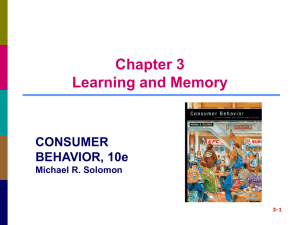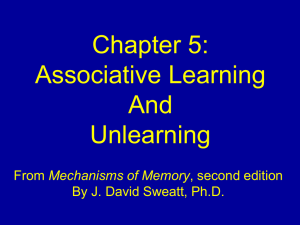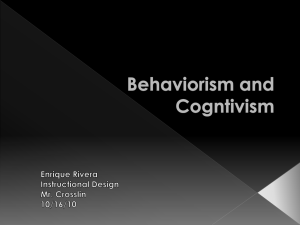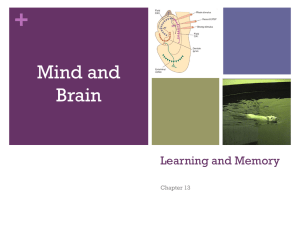Learning & Memory
advertisement
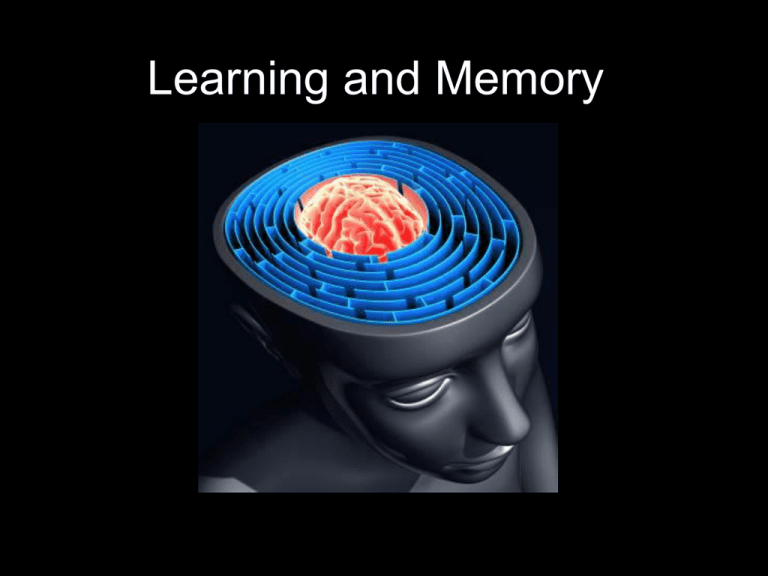
Learning and Memory Learning and Memory Learning relatively permanent change in behavior as a function of training, practice or experience excludes behavioral changes resulting from sensory adaptation or fatigue Learning and Memory memory is implicit in the definition of learning “relatively permanent” implies a lasting alteration of nervous system structure and/or function Two aspects of learning 1. acquisition of a response in presence of a stimulus 2. suppression of responses in its absence Two fundamental questions 1. What are the neural mechanisms of learning? (cellular level) 2. What is learned? (where in the brain; organizational level) To answer the first question, simplified systems have been studied. • Simple forms of learning • Simple systems e.g. invertebrates, simplified mammalian preparations Types of Learning • Non-associative – Habituation, sensitization – perceptual in nature – recognition of objects and situations • Associative – Classical conditioning • S-S learning – Operant Conditioning • R-S learning Associative learning may involve • acquisition of new motor behaviors • acquisition of associations between new stimuli and existing behaviors • acquisition of new associations between familiar stimuli and existing responses. Non-associative learning habituation • • repeated exposure to a stimulus results in reduced responding to that stimulus generally neutral, non-noxious stimuli sensitization • repeated exposure to a stimulus results in increased responding to that stimulus • generally biologically relevant, strong hedonic valence (+ or -) • also refers to augmentation of responding following exposure to a second stimulus Associative learning classical conditioning; Pavlovian conditioning; respondent conditioning •A neutral stimulus is paired with a stimulus that reliably elicits a response. Conditioning is indicated when the previously neutral stimulus elicits a response. CSUSUR CR US UR CR CS Associative learning operant conditioning; instrumental learning •repeated presentation of a stimulus after emission of a designated response increases (reinforces) or decreases (punishes) the likelihood of that response CRUSUR Modeling, latent learning Usually defined as learning in the absence of a reinforcer (US or conditioned reinforcer such as money) Problem: One can always posit a “hidden reinforcer,” a negative hypothesis that cannot be disproven. The burden of proof therefore falls on those to make hidden reinforcers evident. The existence of mirror neurons seems to provide a neurobiological basis for imitative learning. Research on neural mechanisms has focused on non-associative learning and classical conditioning. Eric Kandel and his collaborators used Aplysia to unravel synaptic mechanisms for short- and long-term habituation, short- and long-term sensitization, and classical conditioning. Aplysia Eric Kandel won the 2000 Nobel Prize for Physiology and Medicine for this work. Habituation in Aplysia Sensitization in Aplysia Kandel termed the neural mechanisms that underlie behavioral sensitization, “heterosynaptic facilitation,” which is produced by a second (usually strong) stimulus heterosynaptic facilitation 5-HT released onto presynaptic terminal (metabotropic synapse) c-AMP mediated closure of K+ channels Prolongation of depolarization at the terminal greater Ca2+ influx more neurotransmitter released onto target neuron Memory in Aplysia also involves structural changes in the presynaptic terminal group active zones active zone area vesicles/ active zone vesicles/ neuron naïve 100% .16 um 13 2250 habituated 28 .11 4 500 sensitized 183 .28 20 6300 LTP in the hippocampus: A mammalian model for learning Hippocampus most studied because of it's organization-• complete circuitry represented in thin slices (100-400um thick) • can be placed in a dish for in vitro electrophysiological experiments • also thought to be important for memory consolidation in vivo 20 Copyright © 2004 Allyn and Bacon LTP in the hippocampus: A mammalian model for learning typical LTP experiment 1. stimulate neuron A, record PSP from neuron B 2. stimulate neuron A tetanically (e.g. burst of stimuli @ 100 Hz) 3. record PSP from B w/test pulses at varying intervals 4. PSP augmented for several days or even up to months 5. this augmentation is what is called LTP LTP in the hippocampus: A mammalian model for learning CaMKII: Calcium/calmodulin dependent kinase II PKA, PKC: Protein kinase A, C CREB: cAMP-responsive element-binding protein Low-frequency stimulation results in small increases in [Ca2+] in the postsynaptic cell, which in turn results in fewer AMPA channels opening in response to glutamate. This is called low-frequency depression and is a mechanism for weakening synaptic strength. http://www.sumanasinc.com/webcontent/anisamples/neurobiology/receptors.html Organizational Aspects of Learning and Memory Three gross stages of learning and memory Acquisition Storage Retrieval Organizational Aspects of Learning and Memory There are also qualitatively different kinds of learning Declarative episodic semantic Procedural or non-declarative skill learning priming conditioning Organizational Aspects of Learning and Memory Memory can be categorized according to its duration or persistence Sensory traces e.g. iconic (visual) and echoic (auditory) at most a few seconds in duration Organizational Aspects of Learning and Memory Memory can be categorized according to its duration or persistence Sensory traces Short-term memory (STM) or working memory from LTM information held in “consciousness” phonological loop (sub-vocal rehearsal) visual imagery episodic buffer can be initiated by current event or by recall controlled by “central executive” Organizational Aspects of Learning and Memory Memory can be categorized according to its duration or persistence Sensory traces Short-term memory (STM) or working memory Intermediate-term memory distinguishable from STM and LTM? up to a few days in duration Organizational Aspects of Learning and Memory Memory can be categorized according to its duration or persistence Sensory traces Short-term memory (STM) or working memory Intermediate term memory Long-term memory indefinite duration, up to days Organizational Aspects of Learning and Memory Memory can be characterized by its underlying physical bases Sensory traces persistent activity in sensory pathways Organizational Aspects of Learning and Memory Memory can be characterized by its underlying physical bases Sensory traces Short-term memory (STM) or working memory reverberating circuits electrical basis limited capacity can be disrupted by intrusion of other activity displays both primacy and recency effects Organizational Aspects of Learning and Memory Memory can be characterized by its underlying physical bases Sensory traces Short-term memory (STM) or working memory Intermediate term memory biochemical basis? accessible by working memory eventually irretrievable (storage or retrieval failure?) Organizational Aspects of Learning and Memory Memory can be characterized by its underlying physical bases Sensory traces Short-term memory (STM) or working memory Intermediate term memory Long-term memory structural or anatomical basis protein synthesis essential unlimited(?) capacity Organizational Aspects of Learning and Memory Memory can be characterized by its underlying physical bases Sensory traces Short-term memory (STM) or working memory Intermediate term memory Long-term memory The case of Henry Molaison (H.M.) H.M. suffered from epilepsy, with epileptic foci in both temporal lobes. It did not respond to drugs available at the time and was life-threatening. Therefore, it was decided to remove the tissue in which the epileptiform activity originated. H.M.’s surgery removed the amygdala, the hippocampus, and some of temporal lobe cortex. Patient H.M. EC: Entorhinal cortex H: Hippocampus Cer: Cerebellum PH: Parahippocampal cortex Following surgery, H.M.’s memory of events prior to the surgery was intact (no retrograde amnesia). But, he did display anterograde amnesia, the inability to form declarative memories after the surgery. H.M.’s memory deficit was confined to verbal tasks, with motor learning (non-declarative memory) unaffected. However, H.M. DID display anterograde amnesia for spatial tasks, e.g. navigating new environments There Are Several Kinds of Memory and Learning Studies in animals and other humans with brain damage showed that the H.M.s deficits were unlikely due solely to hippocampal damage. Other temporal lobe structures and the thalamus form a larger functional circuit necessary for consolidation of declarative memories. Damage to other areas can also cause memory loss. Patient N.A. has amnesia due to accidental damage to the dorsomedial thalamus, which is part of the same memory circuit affected by H.M.’s surgery. Like Henry Molaison, he has short-term memory but cannot form declarative longterm memories. Patient N.A. damage of the dorsomedial thalamus damage to floor of third ventricle, mammillary bodies Korsakoff’s Syndrome Korsakoff’s syndrome is a memory deficiency caused by lack of thiamine (vitamin B6)–often seen in chronic alcoholism. Brain damage occurs in mammillary bodies and basal frontal lobes, which produces anterograde amnesia. Patients often confabulate–fill in a gap in memory with a false memory that they fully believe to be true. Organizational Aspects of Learning and Memory Three gross stages of learning and memory Acquisition Storage Retrieval STM is susceptible to disruption prior to consolidation • electroconvulsive shock (or ECT in clinical settings) can disrupt long-term memory by pulling those memories back into working memory at the time of ECT, which prevents re-consolidation • head trauma generally results in retrograde amnesia, whose magnitude is inversely related to the age of the memory, by disturbing ongoing electrical activity • traumatic events may also induce amnesia similar to head trauma or ECS e.g. placing rats in ice water immediately after training trial results in forgetting, or amnesia • may be a model for the loss of memory following psychological trauma (e.g. rape) in humans LTM can be prevented by interfering with protein synthesis Protein synthesis inhibitors block LTP and formation of memories in behavioral tasks. The role of protein synthesis in response to environmental stimulation is very evident in the phenomenon of environmental enrichment “Enrichment” studies are really studies of varying degrees of impoverishment. Rats living outdoors in natural envronmental enclosures exceed “enriched” rats on all measures
